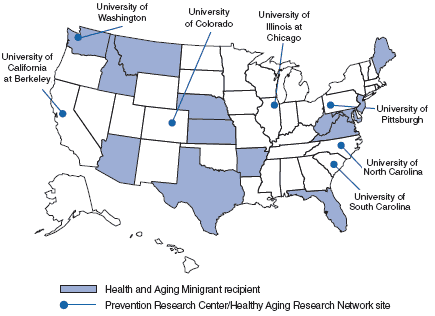
|
 |

CDC’s Roles in Promoting Healthy Aging
CDC promotes the health of older Americans in at least five ways:
- Providing high-quality health information and resources to public
health professionals, consumers, health care providers, and aging experts.
CDC provides reliable, science-based, high-quality information on the
health of seniors for policy makers, health and aging organizations, the
media, and consumers. CDC disseminates this information through such
avenues as publications, conferences, training sessions, and Web sites/listservs.
CDC recently updated its Healthy Aging Web site (http://www.cdc.gov/aging),
which provides timely, practical information to health and aging
professionals as well as the public. Working with the American Society on
Aging, CDC engages journalists across the country on relevant issues such
as disabilities, West Nile virus, and healthy lifestyles.
| |
Myth:
Health inevitably declines as we get older.
Reality: People of any age can improve their health by
adopting healthy behaviors. |
|
|
|
- Supporting health care providers and organizations in their
prevention efforts. Medicare pays for many preventive services, yet
fewer than 1 in 10 adults age 65 or older has received all recommended
screenings and immunizations. In a few areas of the country, programs are
trying creative approaches to help health care providers reach more
seniors.
One such program is the Sickness Prevention Achieved through
Regional Collaboration (SPARC) project. Partially funded by CDC, this
program operates in selected counties of New York, Connecticut, and
Massachusetts. In two counties, SPARC doubled the annual rate of
pneumococcal shots during a single flu season and developed a model method
for redistributing the flu vaccine in seasons when the supply is short,
thus ensuring broader access for populations at risk.
SPARC provides no direct services; rather, it coordinates and
strengthens the efforts of local health care providers and organizations.
CDC hopes to extend the reach of successful programs such as SPARC to
benefit seniors nationwide.
Selected CDC-Supported Healthy Aging
Programs

[A
text description of this map is also available.]
- Integrating public health prevention expertise with the
Administration on Aging’s (AOA) aging services network. As described
in the Older Americans Act, CDC has an advisory role to the aging services
network, which reaches seniors in virtually every U.S. community where
they live and congregate. To take full advantage of opportunities to
improve the health of older adults, CDC strives to integrate public
health’s expertise in research, health tracking, and programs with the
experience and reach of the aging services network. For instance, CDC and
the AOA worked together on the Aging States Project, which identified
aging issues important to state units on aging and state health
departments. The project staff found that all states could benefit from
additional resources and more opportunities to collaborate. In response,
CDC and AOA funded mini grants to 10 states in fiscal year 2003 and 14
states in fiscal year 2004 that facilitate collaboration between the aging
units and health departments on health promotion activities for older
adults.
- Identifying and putting into practice what works in prevention.
Research shows that if seniors maintain just three healthy habits—moderate
physical activity, good nutrition, and no smoking—they can delay
disability by as much as 10 years. The benefits of such research, however,
will never be realized unless this knowledge is applied to programs in
communities. CDC funds many programs that are helping communities reap the
benefits of prevention research. For example, seven of CDC’s Prevention
Research Centers formed a Healthy Aging Research Network, which is
evaluating physical activity programs for older adults to identify which
programs are the most effective.
- Monitoring changes in the health of older Americans. CDC is the
lead national agency responsible for collecting data and monitoring
changes over time in the health of older Americans. This information helps
strengthen efforts to prevent disease, disability, and injury. These data
are also needed to identify health-related disparities among different
groups of older adults and to create culturally appropriate, targeted
interventions. With support from the National Institute on Aging, CDC’s
National Center for Health Statistics has created the Data Warehouse on
Trends in Health and Aging on the Internet. Other databases, such as the
Behavioral Risk Factor Surveillance System (BRFSS) and the Web-based
Injury Statistics Query and Reporting System (WISQARS), also provide
useful information on health trends among older Americans.
Future Directions
Future Directions The first wave of baby boomers, those born in 1946,
will reach age 65 in 2011. As the United States faces the challenge of
responding to the health and social service needs of so many older
Americans, CDC will work to ensure that
- Added years are quality years. CDC’s goal is for older people
to maintain their independence, good health, and engagement in life for as
long as possible.
- Current myths about aging are dispelled. The public must
understand that getting older does not have to mean inevitable decline and
deterioration. People of any age can improve their health if they adopt a
healthy lifestyle.
- Aging issues are seen as public health issues, and the value of
prevention is realized. An enhanced focus on prevention is critical to
helping seniors preserve their independence and reduce their long-term
care needs. Prevention is also the most effective way to stem escalating
health care costs.
For more information or additional copies of this document, please contact
the
Centers for Disease Control and Prevention
National Center for Chronic Disease Prevention
and Health Promotion
Mail Stop K–51
4770 Buford Highway, NE
Atlanta, GA 30341-3717
(770) 488-5464
Fax (770) 488-5486
ccdinfo@cdc.gov
http://www.cdc.gov/aging/
|

|

